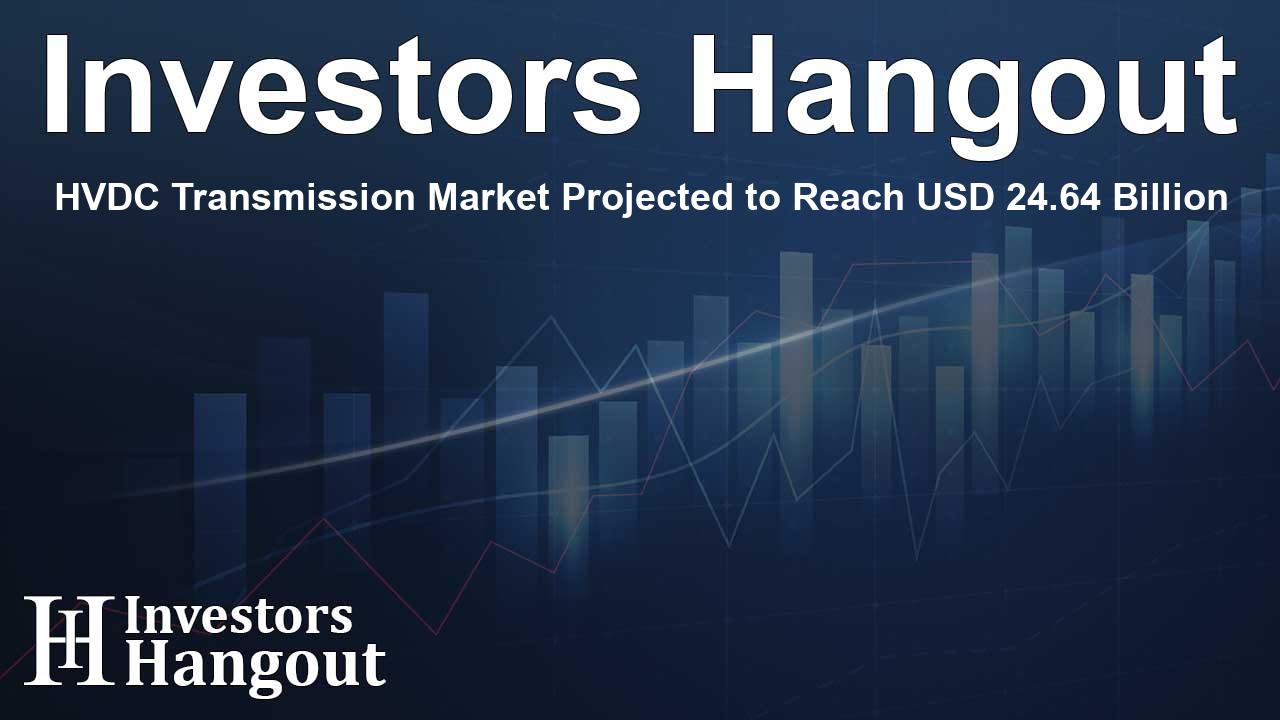HVDC Transmission Market Projected to Reach USD 24.64 Billion

Overview of the Global HVDC Transmission Market
The global High Voltage Direct Current (HVDC) transmission market is exhibiting a promising growth trajectory, anticipated to expand from USD 10.24 billion in 2023 to USD 24.64 billion by 2033. This growth reflects a robust Compound Annual Growth Rate (CAGR) of 9.18% during the forecast period. The increasing demand for efficient long-distance power transmission systems underlines the growing relevance of HVDC technology in today's energy landscape.
Understanding HVDC Technology
HVDC transmission is a sophisticated technology designed for transmitting electricity over long distances using direct current (DC) rather than alternating current (AC). This system employs inverters and rectifiers for converting AC to DC and vice versa, while also utilizing components such as smoothing reactors and harmonic filters to minimize electrical interference and ensure stability. Given its capability to effectively connect diverse power systems and overcome geographical barriers, HVDC becomes particularly relevant for underwater and underground transmission lines, which are critical in a world striving for decarbonization and the integration of renewable energy sources.
Market Drivers and Challenges
As the world moves towards a greener energy paradigm, the significance of high-voltage direct current transmission systems is surging. However, the costly nature of HVDC systems remains a potential obstacle to market growth. Despite this challenge, the benefits of HVDC systems—such as their operational efficiency and long-range transmission capabilities—are propelling their adoption in various sectors. Furthermore, the development of favorable regulations, especially in regions like Asia-Pacific, is fostering an environment conducive to market expansion.
Market Segmentation Trends
Bipolar Link Dominance
Segmented by HVDC links, HVDC transmission can be classified into monopolar, bipolar, and homopolar links. Among these categories, bipolar links dominate the market due to their ability to continue functioning even if one conductor fails, thanks to the ground return system.
Voltage Source Converter (VSC) Technology Leadership
When examining technological segmentation, the voltage source converter (VSC) technology has emerged as the leader in market share. These self-commutated converters allow for efficient control of both active and reactive power. An example of this technology in action is the Pugalur-Thrissur 2000 MW HVDC System, which plays an essential role in ensuring a stable and reliable power supply over considerable distances.
Regional Market Insights
The Asia-Pacific region is poised to dominate the global HVDC transmission market, driven by increasing HVDC project undertakings in countries like China and India. As advancements in manufacturing materials enhance the reliability and efficiency of underground high-voltage cables, this region is expected to witness significant growth. Concurrently, North America is projected to experience swift growth rates, largely due to increased reliance on renewable energy sources and substantial investments in transmission infrastructure.
Competitive Landscape
A detailed competitive analysis reveals key players shaping the HVDC transmission market, including prominent companies such as Hitachi Energy, General Electric Co., Mitsubishi Electric Corporation, and Siemens, among others. The market analysis provides insights into various corporate strategies, recent developments, and innovations, ensuring a comprehensive understanding of the competitive dynamics.
Recent Developments in HVDC Transmission
- In a recent initiative, the U.S. Department of Energy announced a funding opportunity aimed at advancing voltage source converter transmission systems, signaling a strong push towards innovative solutions in the HVDC space.
Frequently Asked Questions
What is HVDC technology?
HVDC technology is a method for transmitting electric power over long distances using direct current instead of alternating current, allowing for efficient long-range power transmission.
What are the main benefits of HVDC systems?
The primary benefits of HVDC systems include reduced transmission losses, improved efficiency, adaptability to renewable energy sources, and the ability to connect remote generating stations to load centers.
Which technology leads the HVDC market?
Currently, the voltage source converter (VSC) technology leads the market due to its efficient power control mechanisms and the ability to operate independently of the AC system.
Which region is experiencing the fastest growth in HVDC transmission?
The Asia-Pacific region is seeing rapid growth in HVDC transmission projects, driven by robust demand for renewable energy and supportive government regulations.
What challenges does the HVDC market face?
The main challenges include high initial installation costs and the need for specialized technology and infrastructure, which can limit the adoption of HVDC systems.
About Investors Hangout
Investors Hangout is a leading online stock forum for financial discussion and learning, offering a wide range of free tools and resources. It draws in traders of all levels, who exchange market knowledge, investigate trading tactics, and keep an eye on industry developments in real time. Featuring financial articles, stock message boards, quotes, charts, company profiles, and live news updates. Through cooperative learning and a wealth of informational resources, it helps users from novices creating their first portfolios to experts honing their techniques. Join Investors Hangout today: https://investorshangout.com/
Disclaimer: The content of this article is solely for general informational purposes only; it does not represent legal, financial, or investment advice. Investors Hangout does not offer financial advice; the author is not a licensed financial advisor. Consult a qualified advisor before making any financial or investment decisions based on this article. The author's interpretation of publicly available data shapes the opinions presented here; as a result, they should not be taken as advice to purchase, sell, or hold any securities mentioned or any other investments. The author does not guarantee the accuracy, completeness, or timeliness of any material, providing it "as is." Information and market conditions may change; past performance is not indicative of future outcomes. If any of the material offered here is inaccurate, please contact us for corrections.